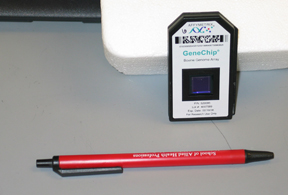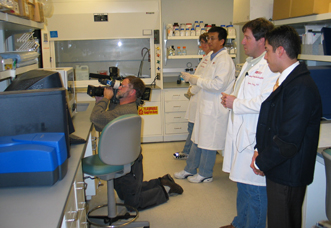 |
This is a bovine gene chip made by Affymetrix. The chip — about the size of a typical domino — looks the same as the monkey gene chip except the monkey gene chip is labeled Rhesus Gene Chip. |
Robert Norgren, Ph.D., associate professor in the department of genetics, cell biology and anatomy, was the principal investigator on the project, which resulted in a GeneChip that will allow scientists to more efficiently study the genes of the rhesus macaque monkey, the most commonly used monkey in biomedical research.
Through a more than $2.25 million grant from the National Center for Research Resources (NCRR) at the National Institutes of Health, Dr. Norgren and his colleagues were able to obtain over a two-year period the necessary DNA sequence information for many of the genes in the macaque monkey. Once the sequencing was completed, Affymetrix, a gene technology company in Santa Clara, Calif., was able to develop the GeneChip” Rhesus Macaque Genome Array. The research was featured in the spring 2005 issue of the NCRR Reporter.
The gene chip will allow scientists to study all the 20,000 monkey genes at one time and determine when and where genes are being turned on, or expressed. Because the genes of these monkeys are most similar to the genes of humans, they play a key role in our understanding of human disease, development and reproduction.
Although gene chips for humans and mice have existed for sometime, this is the first time Affymetrix has produced a monkey GeneChip.
The new GeneChip is now available, Dr. Norgren said, and the response from the scientific community has been very enthusiastic.
 |
Three members of the UNMC DNA Microarray Core Facility watch as KMTV (Ch. 3) photographer John Haxby shoots video of the equipment used in microarray research. From left-right are: Lisa Bough, Tong Yin, M.D., James Eudy, Ph.D., and KMTV reporter Corey Rangel. The lab is directed by Dr. Eudy. All three are members of the Department of Genetics, Cell Biology and Anatomy. |
Dr. Norgren said the GeneChip represents an important breakthrough in monkey genomics. “Because the genes of monkeys are so similar to humans, they are the best animal to use when trying to develop new vaccines,” he said. “Scientists who study AIDS should be the biggest benefactors of this GeneChip, as their research is focused on monkeys.”
Howard S. Fox, M.D., Ph.D., director of NeuroAIDS Preclinical Studies at the Scripps Research Institute in La Jolla, Calif., has used the new GeneChip and is excited about its potential. “This is a great advance for our brain research dealing with AIDS patients and HIV-dementia,” he said. “The GeneChip is much more sensitive. It allows us to look at the whole genome and detect and quantify many more genes. This is especially important in brain research, since there are more genes expressed in the brain than anywhere else in the body.
|
|
“With the AIDS virus, it oftentimes goes to the brain early and results in chronic problems in the patient. Dealing with this chronic stage of the disease is the focus of our research. The new chip will allow us to look at the chronic stage of infections and better determine how the central nervous system functions are affected.”
The new GeneChip will allow scientists to study an oligonucleotide (a small DNA sample) microarray, which consists of a small piece of glass, only a few inches large, containing tens of thousands of probes that can determine whether a gene is turned on or off in a particular cell. In this way, researchers can look at the state of all of the genes in an organ at one time, something that was not possible with previous methods, Dr. Norgren said.
This allows scientists to look for patterns of expression that can clue them into what biological processes are involved in diseases, he said, which could result in new ways to help treat those diseases.
The monkey GeneChip also will help alleviate the shortage of monkeys used in research, Dr. Norgren said, as far fewer animal experiments will need to be conducted to answer scientific questions.